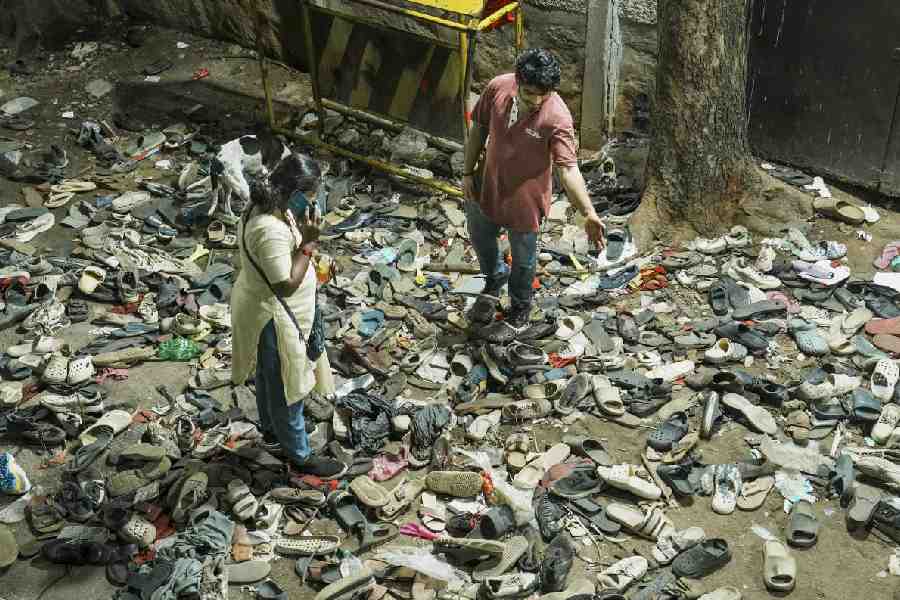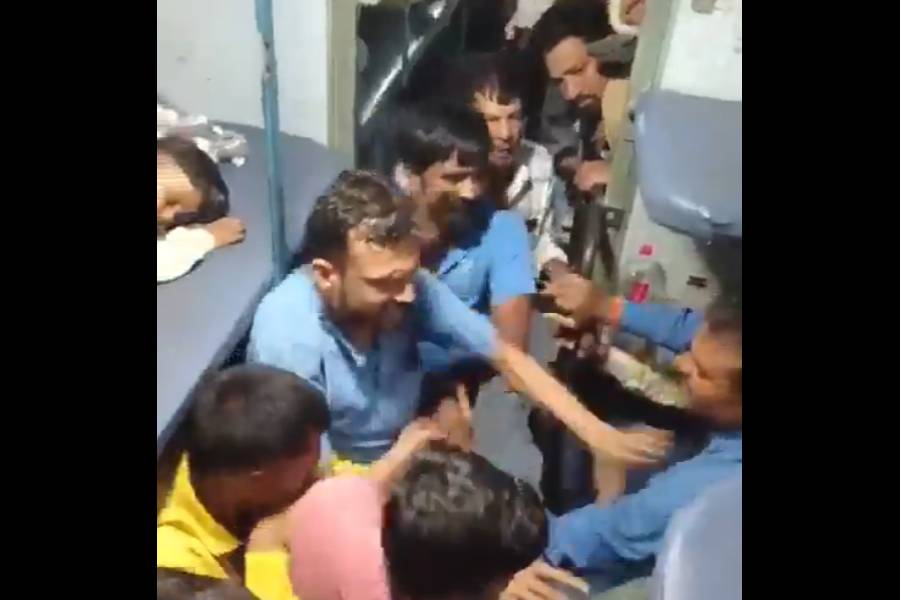 |
| Bodies of AMRI victims at SSKM Hospital on Friday. Picture by Pradip Sanyal |
Thirty years ago, on the morning of December 4, 1981, a bulb blew in the spiral stairwell of Qutub Minar. Sudden darkness triggered shrieks of panic, and soon after, a chaotic human slide. The girded rope of visitors twisting slowly up the medieval tower collapsed on itself. Forty-six of the 300-odd in the column, most of them school children on a dekko, were strangled.
By the time reporters reached the scene, the dead had been carted away and most of the injured had limbered off. What remained was a lone Delhi police sentry guarding a shambled pyramid of footwear at the darkened mouth of the Minar. You’d look at it today and think it’s a Subodh Gupta installation. But that pile was no art; it was a work of crime, a stinky compost of institutional dereliction and our yen for public disorder, often mistakenly celebrated as a vibrant thread in the rich weave of Indian culture.
The way up Qutub Minar was dark, even with that errant bulb aglow. Parts of the handrail had given. The steps were mercilessly eroded by centuries of eager footfall. There were no guards, and many more people had shot up the vertical tunnel than safety permitted. Calamity awaited them.
Correctives were immediately ordered. An iron grill was commissioned and the entrance to Qutub Minar forever barred.
In the three decades since, India has taken long and lofty strides — a boom story that has barged into the global Big Boys’ Club and made demands that they can no longer ignore. Its IT prowess is colonial, its expanding market an insistent lure. Villages have become townships, townships cities. Its metropolises have become swift and burnished in the glow of cumulative growth. In its capital now resides an acknowledged nuclear button.
But should they unlock that rusting gate at the bottom of Qutub Minar today, there’d be no guarantee December 4, 1981, will not be repeated.
All they imposed is prohibition in the name of correction. Not improved lighting, not stable handrails, not more guards, not a mechanism to stagger entry and exit. Just a padlocked iron grill. Cast it away, and the recipe for ruin still swirls in the tower.
As Mihir Bhatt, director of the All India Disaster Mitigation Institute, which has an established subcontinent-wide record of work in the field, says: “When we as a people, when government and businesses do not invest in prevention, the citizens pay in terms of their losses. This is a story that refuses to die, it only kills more and more.”
Terror, in recent years, has menaced us most with its talent for claiming untimely toll — Mumbai, Malegaon, Pune, Srinagar, Delhi, Varanasi, it has leapfrogged wantonly, wreaking havoc, spewing an epidemic of see-you-soon paranoia in its wake. Terror continually haunts us. But we seem afflicted by suicidal amnesia over what we inflict on ourselves.
 |
Terror affords us benefit of doubt over preparedness, it surprises us with its accosts. There lies an excuse. There is no surprise in a hospital spark turning a killer inferno. Or in the Bhopal leak. Or the Uphaar cinema charnel house. Or Qutub. Or the many killer stampedes that visit Kumbh melas: 48 dead at Haridwar in 2005, most of them widows too frail to resist the tramp of human heels; 350 killed at Nashik in 1989; 48 killed by short-circuiting at the Mandhar Temple in Satara in 2005; 162 in a wildebeest run of humans down the ramp of the Naina Devi Temple in Himachal Pradesh in 2008 after a thunderclap touched off a scare.
Each time we surprise ourselves by our refusal to remember or to learn. There is no place for excuses in man-made misfortunes such as the one that was summoned to the wards of AMRI late last night. There is only forgetfulness and dereliction over simple, but critical, things: a no-go sign violated, a cordon not bothered with, a barrier cavalierly transgressed in the face of peril, a rail crossing not manned, a sentry not on duty, a metal detector unmindfully brandished, an elevator past its overhaul-by date, an inflammable vat carelessly placed, an extinguisher that does not fire, a building licensed to incinerate, or to collapse upon its inhabitants. Collective uncaring.
Where does this come from? Insensitivity? Cynicism? Fatalism? An overabundance of human supplies that cheapens per capita value we put on lives? Does the construct of average lives in these parts have something to do with the way in which crisis is almost treated as quotidian? Where each day is Judgement Day and it is reasonably certain the Messiah isn’t coming? There isn’t an option but to wage on with whatever is available. Nothing’s sacred, everything goes. Cry, complain, move on. It’s our collective culture, too formidable a prospect for mortals to grapple with or alter.
It is probably also culture to employ overblown diagnostics for rudimentary ailments. The most monumental tragedies can be born from the most basic failures. There are simple — and all too obvious and available — preventives. A matchbox structure with no functioning firefighting arrangements should beggar belief, and attract action from authority.
But we seem to have made a rare thing of common sense, a bogey of the simplest rules to live safely by — systems, enforcement, compliance. They work, but only when someone decides to make them work. Ahead of the 2010 Commonwealth Games in Delhi, exclusive traffic lanes were marked out in blue for event vehicles and a directive publicised that violations will be penalised. Delhiites were, probably justly, sceptical.
But come the Games, and they surprised themselves. Not so much as a wheel transgressed into the demarcated blue lanes. It was a simple trick of enforcement. There was enough buzz on penalties, enough traffic cops deployed. That secured compliance. Delhi roads ran smoother during the Games than at other times. The moment the Games closed, though, the vigil was off and violations resumed. How long ago was it that Park Street was wrapped in deathly flames? How long has it taken for horrors of delinquency to have been forgotten just a skim-and-curve down the road in Dhakuria? Or perhaps nobody learnt a thing. That iron gate on Qutub Minar better stay hinged.
 |










